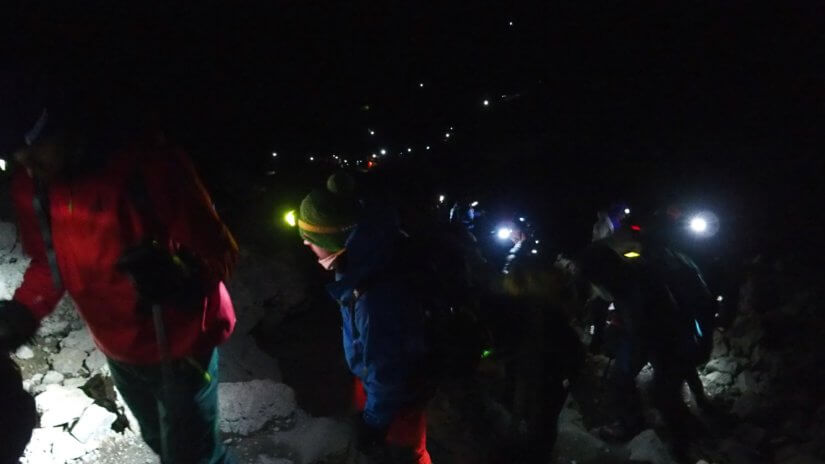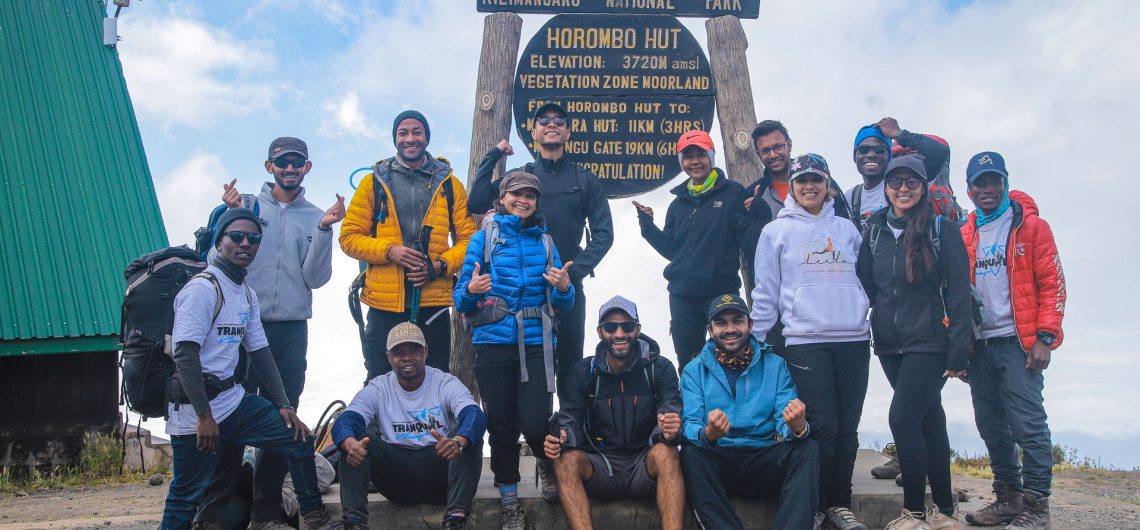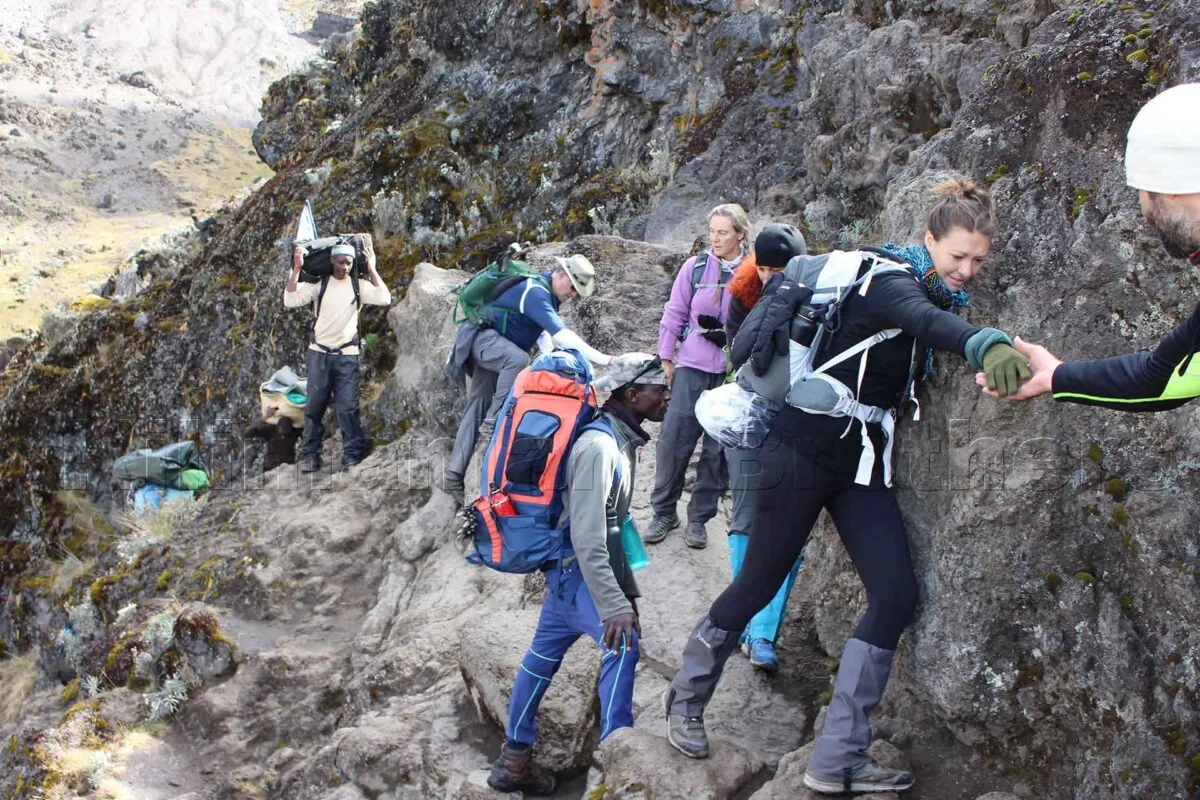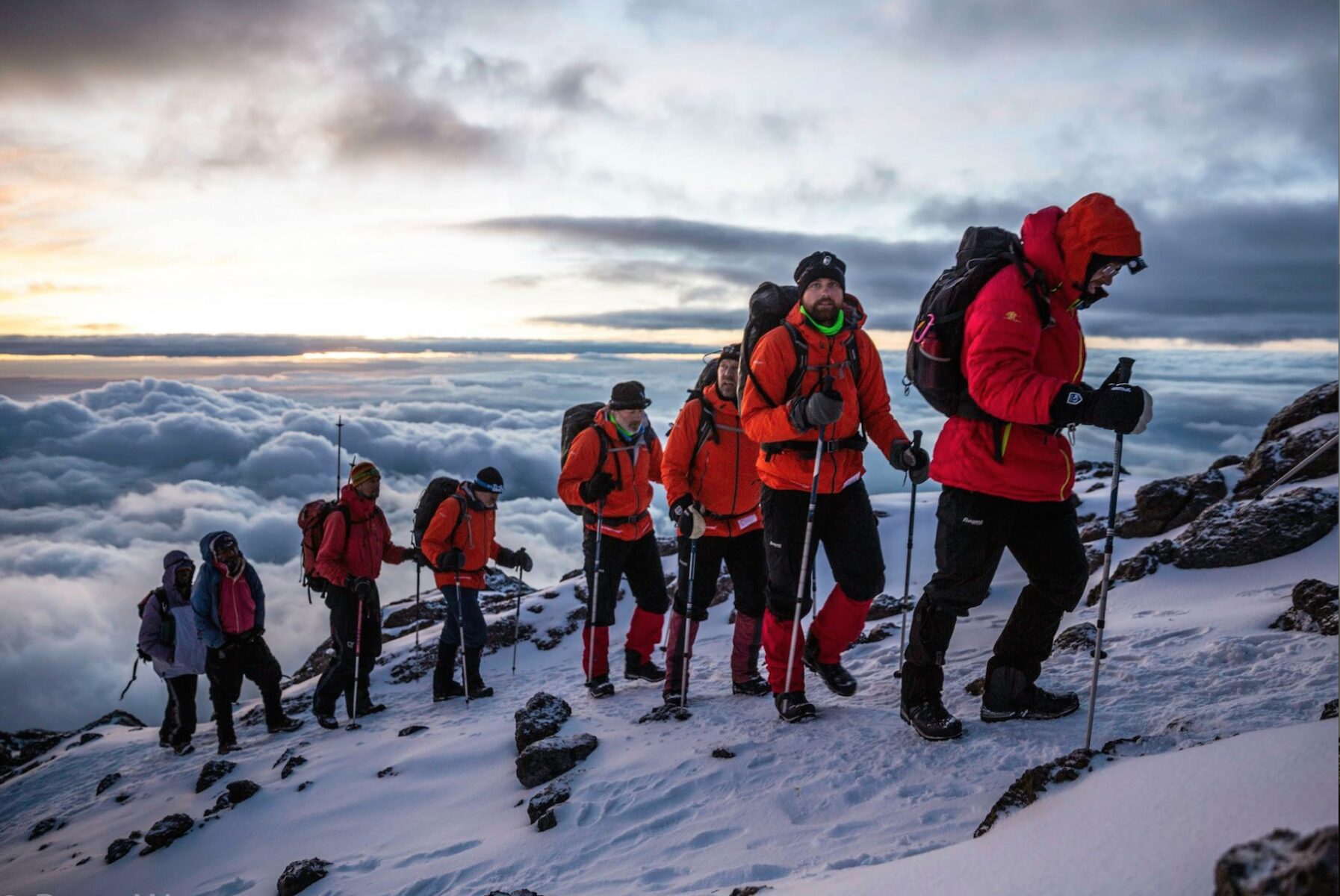Mount Kilimanjaro is not technically difficult as it is a walkable mountain, but that doesn’t mean it is a walkover. First of all, you should come prepared and expect to experience rugged terrain, extreme weather conditions, a test of stamina over varied ecological zones, and above all it is a huge mental test.
When people ask us, how hard is climbing Mount Kilimanjaro? There are many aspects that come to mind, for example when you compare Mount Kilimanjaro to Mount Everest, you will find Mount Everest to be harder. Even the other mountains on the seven summits give Kilimanjaro a better chance of summiting in terms of difficulty. Heck, even Mount Aconcagua is possibly harder to climb than our very own Mount Kilimanjaro.
Most of the time, climbing Kilimanjaro is not tough because the routes are not steep; instead, the difficulty comes from adjusting to the altitude. However, the summit night is incredibly challenging because it is the coldest and windiest part of your journey. a 4,084-foot ascent with 49% less oxygen and a roughly 6,870-foot drop. Up to 12 to 14 hours of walking may be required.
How difficult is it to climb Kilimanjaro? Is one of the very many questions we frequently get asked and one we frequently see in the various forums. The answer to this question is rather ambiguous because it is highly individualized and dependent on a variety of variables.
After all, what one person finds “hard” may come naturally to another.
And doesn’t the difficulty of anything increase its satisfaction?
What is the hardest part of climbing Kilimanjaro?
The summit night, making that journey to the summit of Mount Kilimanjaro at around midnight or shortly after, and in total darkness, is the hardest part of climbing Kilimanjaro. That is according to many people who have then gone on to climb this mountain in Tanzania. Although we haven’t yet encountered someone who believes it to be “simple,” it always depends on what you’re comparing it to. Battling altitude sickness is another challenging situation that you might face while on the mountain, that plus extreme cold weather especially at the top is possible among the top reasons, Kilimanjaro treks are termed challenging.
Kilimanjaro is somewhat “easy” in comparison to Everest.
It’s “challenging” in comparison to a leisurely stroll down the beach or just a hike up a normal hill.
Let’s examine some of the key elements that influence Kilimanjaro’s difficulty and what you may do to mitigate them.
Technical Difficulty of Climbing Kilimanjaro
If there are any technical difficulties involved in climbing Kilimanjaro, it is one of the first things that novice and aspiring mountain climbers want the answer to.
There’s none. Kilimanjaro is a trekking peak that may be ascended without the need of an ice axe, ropes, or harnesses, or a “walk-up.” Technical mountaineering expertise is not at all required. Maybe the only challenging part could be the Barranco Wall, but still, not all routes pass through the Barranco Wall.
Read more about how to climb the Barranco Wall.
 The challenges that come with high altitudes
The challenges that come with high altitudes
The hardest part of climbing Kilimanjaro is actually this. Kilimanjaro differs from a typically long day of trekking in that it requires you to adjust to the low oxygen in the air while yet covering vast distances. One of the preparations you can make to increase your likelihood of being able to manage the altitude is Kilimanjaro altitude training, however, it can be somewhat unpredictable.
As you won’t be in a rush to make up the mileage, taking a long route—6+ days—will give your body more time to adjust and allow time for proper rest and recovery. How challenging is the Kilimanjaro climb?
Always move forward at a slow pace. If it seems a little counterintuitive, you’ll notice that your guide will frequently say “Pole pole,” which is Swahili for “slowly slowly.” You’ll preserve energy, avoid exhaustion, and increase your chances of successful acclimation by maintaining a very modest speed! Folks, it’s not a race…
In order to aid in acclimatization, you can also think about taking Diamox. For it, you’ll require a prescription from your doctor.
Fitness issues
It goes without saying that the walk would be considerably more difficult if you are very physically unprepared and unfit. There is frequently a lot of uncertainty around how fit you should be. Although you don’t have to be an ultra-marathon runner, you must be physically fit enough to walk for several hours while carrying a heavy rucksack. then repeat the process the next day.
How effectively or how poorly you recover from each day’s trekking will depend on your level of fitness. As was already indicated, you’ll be moving so slowly that, if it weren’t for the altitude, you’d probably become weary of the pace!
How healthy should you be to climb Kilimanjaro? is always our recommendation that you consult your doctor to approve your trek if you have any underlying conditions and health issues.
To that aim, we have put together a thorough guide on how to prepare for the Kilimanjaro climb that you can find here.
Make an attempt to be as fit as you can; nevertheless, don’t imagine that you need to be an outstanding athlete. This will just make your preparation more difficult.
Learn more and download the Kilimanjaro fitness and training plan
Sleeping conditions & camping on the mountain
You could initially find camping and sleeping on Kilimanjaro challenging if you’re used to only being able to sleep in your own bed with fluffy white sheets. Even though we offer cozy sleeping bags and soft sleeping mats, it could take some getting used to if you’ve never slept in a tent before.
Camping will feel nearly luxurious for people who spend their weekends sleeping on the ground in the wilderness because you don’t have to prepare your own meals or set up your own tent!
Your ability to sleep well is crucial to your rehabilitation. Consider choosing the Marangu route, where you stay in huts if you suspect this part of climbing Kilimanjaro may be difficult for you. Better yet, borrow a tent and spend a night or two practicing in your backyard.
We’ve spoken to people who were extremely concerned about how challenging sleeping in a tent and camping would be. By the time they reach the top, they frequently express how much they will miss it when they return home.
Read more about Mount Kilimanjaro’s sleeping conditions.
 Temperature & weather conditions
Temperature & weather conditions
Extreme or Adverse weather conditions might also make climbing Kilimanjaro a challenge. Although the weather in the mountains is famously variable, some seasons are preferable to others in terms of rain. (see Month and Best Time to Climb Kilimanjaro)
It’s chilly. very chilly The temperature decreases dramatically at night as you ascend. If you are aware that you are sensitive to the cold, you must be ready and carry the appropriate equipment. Your life on the mountain could become quite difficult if you bring the wrong equipment. Check out our Kilimanjaro packing list.
Health Issues
Of course, you might find it harder than others if you have additional medical issues or an injury that makes walking or carrying a bag problematic. If you’re in good enough health to climb Kilimanjaro, your doctor can give you advice on that. But be inspired by some of the individuals who have scaled Mount Kilimanjaro despite the odds being stacked against them!
Additionally, it’s critical to maintain your health when hiking. Maintaining proper cleanliness is important, especially before meals, to prevent stomach issues. Of course, you should also make sure that the group you are climbing with practices strict food preparation hygiene!
Learn how to keep clean on your Kilimanjaro climb.
Mount guide’s experience
The difference between a successful, risk-free summit and an early descent due to altitude sickness can be determined by the guide you are with, so make sure they are qualified, experienced, and trained in high-altitude medicine.
It is crucial to have faith in your guide since it can ease some of the stress that comes from wondering about how you are adjusting to the altitude. You may feel more confident about moving forward, even on days when it seems a little “too hard,” if you are able to communicate any symptoms you experience to your guide and receive daily medical checks.
Additionally, attending in a group might be a wonderful way to share the experience and, although it won’t be any less physically challenging, it might be less emotionally challenging!
Check out our mountain guides.
Mental Stamina
Be positive and optimistic at all times!
A lot has been said about Kilimanjaro climbers’ physical preparedness. Your mental toughness, though, is arguably even more crucial than your physical toughness. Some people don’t fully understand their mental toughness until they are faced with a problem.
Long days on the trail, being far from home, sleeping in tents, and hiking in arduous, chilly weather are all factors that might increase the climb’s emotional or mental challenge.
The long, difficult, uphill slog can seem endless, especially on summit night; it is only your mental fortitude that keeps you going.
You might be tougher than you believe! But it’s important to keep in mind that climbing Kilimanjaro may be just as difficult mentally and emotionally as it is physically.
Never forget your “why.” What motivated you to conquer Mount Kilimanjaro? Why did you travel to Africa to climb this massive mountain? When times are tough, remembering your own personal motivations for doing this trip may be a fantastic source of inspiration.
Maintain your optimistic attitude and focus on the mountain’s beauty that surrounds you while you soak in the memorable experience. You’ll always remember how difficult it was to reach the summit.
Read about some tips on how to reach Uhuru Peak
Mountain Gear & Equipment
We’ve already discussed this. There are detailed packing lists available; it’s not just about the equipment you bring with you.
The equipment your tour operator brings is equally crucial. Make sure the climbing organization you choose employs equipment designed for mountainous terrain. Even if you have all the necessary equipment, it won’t help if you’re sitting on broken chairs and sleeping in a wet tent. Choose your business carefully to ensure that everything is kept in good working order. For more information, read our post on how to choose the best Kilimanjaro route.
It’s vital to break in your footwear. Don’t wait to start until you reach Africa.
Wear them whenever you have the chance to go hiking, walk around the house in them, or utilize the treadmill. Ensure that you carry your weighted pack and become familiar with its adjustments and how it works with various layering arrangements. Make stacking a habit by doing it until it comes naturally.
Read about how to choose the best boots for climbing Kilimanjaro
Energy giving food and water!
This ascent will be exceedingly challenging if you’re dehydrated. Your capacity to acclimatize and recover from a demanding day on the trail will be impacted. You should drink a lot of water; if you find this difficult, you can add flavorings in the form of electrolyte powders or liquids, or if you’d rather, just some basic squash.
You will expend a lot of calories, so you must replenish them. You’ll have more energy throughout the day and will be better able to recuperate from the demanding activity if you eat enough. Since altitude might influence your appetite, bring some of your favorite energy bars or snacks from home. These sweet treats may encourage you to eat even though you’re not very hungry.
Read about the Kilimanjaro meals and drinks
Do you have any concerns regarding the difficulty of climbing Kilimanjaro? Our staff is prepared to respond to them for you! Have you climbed Kilimanjaro? If so, how difficult was it? Do you have any tips? Comment below and let us know!
![]()


 The challenges that come with high altitudes
The challenges that come with high altitudes Temperature & weather conditions
Temperature & weather conditions
Comments